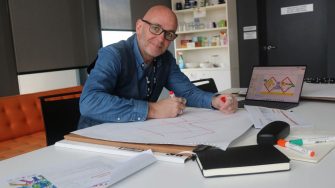
When Sydney wakes, the doors of Wayside Chapel are open, welcoming those seeking refuge from the harsh realities of life on the streets.
A hot shower, clean clothes, and a warm smile await. For many, this is not just shelter from the cold, it is a place of hope, where dignity is restored, and community is found.
UNSW Centre for Social Impact Lecturer, Lee Cooper (pictured above), knows all too well the complex social issues that Wayside Chapel faces every day. As the former Head of Innovation, Strategy & Social Impact at Wayside, Lee innately understands the need for organisations like this to work around the clock.
“Wayside operates 7 days a week, social impact goes beyond business hours,” said Cooper.
The importance of context in social impact
According to Lee, a framework for collective cohesion cannot be developed in isolation. His course ‘Design for Social Innovation’ at UNSW Centre for Social Impact, emphasises real solutions must be informed by the front line and directly address the immediate needs of communities.
“You cannot plan from the boardroom. True impact happens when you engage directly with the environment where people live, come together and connect. It is what we call design from the ‘life world.”
Organisations like Wayside are rooted in the community, and the location itself contributes to the conditions of meeting people. The goal isn’t to solve a problem of a person, but to meet them and understand how these challenges form. If you don’t understand their context, their space and place, you miss seeing the person.
“Wayside’s location in Kings Cross is no accident—it’s a place where the most marginalized in society gather,” said Cooper.
With a growing demand for future leaders with experience in social innovation and design, UNSW Centre for Social Impact partnered with Wayside Chapel, taking students out of the classroom and into the heart of those working on the front line with people living below the line.
“It really brought to life the teaching of the course. How can you design an approach if you don’t try to connect with and understand the true nature of the problem and the people who experience it? Overlaying a solution that was not created for a particular situation can help problems remain unsolved,” reflects Michelle Hanna, ‘Design for Social Innovation’ alum.
Capturing social complexity
Armed with their cameras, students are tasked with capturing images of place that reveal the complexities of the location in which they are immersed. Michelle’s lens told the story of the iconic McElhone Stairs near Wayside Chapel, showing the striking contrast in wealth where million-dollar properties are juxtaposed against the struggle against poverty, mental health, and homelessness.
“It seemed to strike many of us as both an entry or exit point from one world to another – a sunnier, more privileged life upstairs at Potts Point, and a colder, more challenging experience downstairs at Woolloomooloo. This is of course a generalisation, and life can be challenging upstairs or downstairs, with people in both a privileged or more disadvantaged life ‘medicating’ their pain with different drugs,” said Michelle.
Real-life experiences transforming social impact students
“The Design for Social Innovation course was transformative. It helped me realise that big problems aren’t entirely unsolvable if you approach them in small ways, meeting people where they are at and co-designing meaningful and relevant approaches towards improved conditions.”
